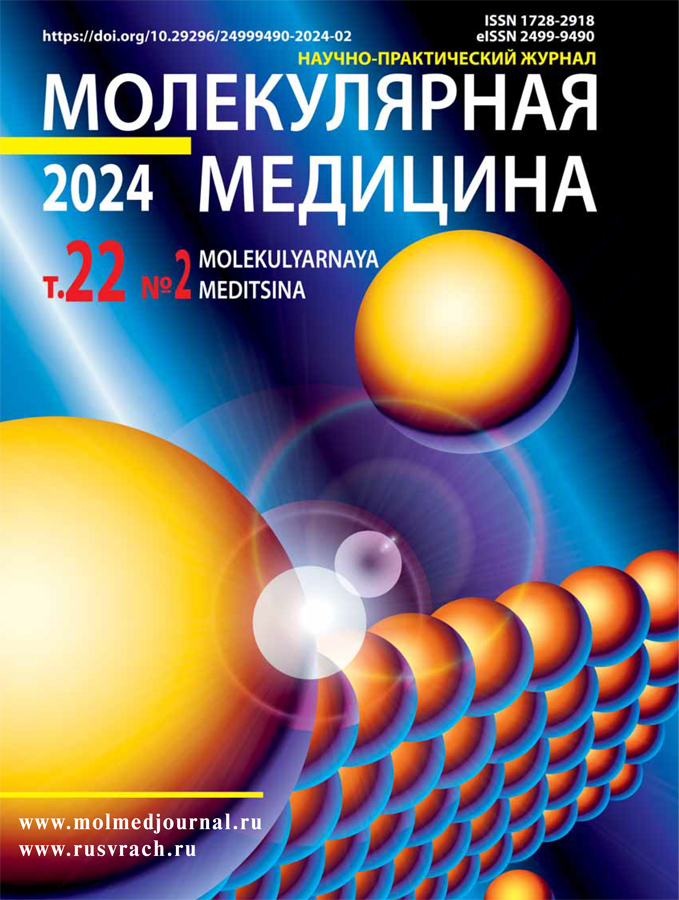Features of the metabolism of sialoglycoproteins in the tissues of the liver, stomach and small intestine of rats under immobilization stress
- Authors: Oksuzyan A.V.1, Butolin E.G.1, Sutyagina A.D.1, Perminov A.V.1
-
Affiliations:
- Izhevsk State Medical Academy of the Ministry of Health of Russia
- Issue: Vol 22, No 2 (2024)
- Pages: 43-47
- Section: Original research
- URL: https://journals.eco-vector.com/1728-2918/article/view/630269
- DOI: https://doi.org/10.29296/24999490-2024-02-07
- ID: 630269
Cite item
Abstract
Introduction. Immobilization stress leads to the intensification of free-radical reactions leading to the destruction of sialoglycoproteins of the gastroduodenal zone. The aim of the study. To evaluate the features of the metabolism of sialoglycoproteins in the tissues of the liver, stomach and small intestine of rats under immobilization stress.
Methods. Total sialic acids (TSA) and levels of sialidase activity (SA) were determined in the serum, liver, stomach, and small intestine tissues of rats by standard testing systems in dynamics on the 21st, 35th, 60th and 90th days of observation.
Results. The blood serum of laboratory rats showed a maximum increase in total sialic acids and sialidases by 35 days of stress exposure, while in the liver, on the contrary, a decrease in the above-mentioned indicators. In the mucous overlays of the stomach and small intestine, the number of TSA increased throughout the dynamics of observation, and the activity of sialidase decreased by day 21 and increased in the following days of the experiment. In the wall of the stomach and small intestine of experimental rodents, the level of TSA increased by the 35th day of observation.
Conclusion. During immobilization stress in the exchange of sialoglycoproteins, a compensatory predominance of anabolic processes in liver tissues was noted against the background of the prevalence of catabolism in the mucosal layer of the stomach and small intestine on days 21, 35 of observation, changes in the walls of the above organs are less pronounced and manifest themselves at a later date.
Full Text
About the authors
Artur V. Oksuzyan
Izhevsk State Medical Academy of the Ministry of Health of Russia
Author for correspondence.
Email: artur30st@mail.ru
ORCID iD: 0000-0002-5901-615X
Dean of the Faculty of Additional Education, Assistant Professor of the Department of Disaster Medicine and Life Safety Izhevsk State Medical Academy, PhD in Medical sciences
Russian Federation, Kommunarov str., 281, Izhevsk, 426056Evgeny G. Butolin
Izhevsk State Medical Academy of the Ministry of Health of Russia
Email: butoline@mail.ru
ORCID iD: 0000-0002-3312-4689
Head of the Department of Clinical Biochemistry and Laboratory Diagnostics of the FPC and PP, Izhevsk State Medical Academy, Professor, Grand PhD in Medical sciences
Russian Federation, Kommunarov str., 281, Izhevsk, 426056Anastasia D. Sutyagina
Izhevsk State Medical Academy of the Ministry of Health of Russia
Email: anas.resetnikowa@yandex.ru
ORCID iD: 0000-0002-4117-4117
5th year student of the pediatric faculty Izhevsk State Medical Academy
Russian Federation, Kommunarov str., 281, Izhevsk, 426056Artemiy V. Perminov
Izhevsk State Medical Academy of the Ministry of Health of Russia
Email: art.perminov@mail.ru
ORCID iD: 0009-0009-9851-5646
6th year student of the pediatric faculty Izhevsk State Medical Academy
Russian Federation, Kommunarov str., 281, Izhevsk, 426056References
- Жигулина В.В. Биохимический ответ на стресс (обзор литературы). Тверской медицинский журнал. 2015; 1: 91–100. [Zhigulina V.V. Biochemical response to stress (literature review). Tver medical J. 2015; 1: 91–100 (in Russian)]
- Торгашов М.Н., Мякотных В.С. Некоторые патогенетические механизмы развития стресс-индуцированной патологии. Вестник Уральской медицинской академической науки. 2016; 2: 64–74. doi: 10.22138/2500-0918-2016-14-2-64-74 [Torgashov M.N., Mjakotnyh V.S. Some pathogenetic mechanisms of stress-induced pathology. J. of Ural Medical Academic Science. 2016; 2: 64–74. doi: 10.22138/2500-0918-2016-14-2-64-74 (in Russian)]
- Протасова С.В., Бутолин Е.Г. Состояние коры надпочечников и обмен гликозаминогликанов печени крыс при длительном иммобилизационном стрессе. Морфологические ведомости. 2008; 3–4: 199–200. [Protasova S.V., Butolin E.G. The state of the adrenal cortex and the exchange of glycosaminoglycans of the rat liver during prolonged immobilization stress. Morphological newsletter. 2008; 3–4: 199–200 (in Russian)]
- Фоменко С.Е., Кушнерова Н.Ф., Спрыгин В.Г., Момот Т.В. Нарушение обменных процессов в печени крыс под действием стресса. Тихоокеанский медицинский журнал. 2013; 2: 67–70. [Fomenko S.E., Kushnerova N.F., Spryigin V.G., Momot T.V. Disturbances in metabolic processes in liver of rats exposed to stress. Pacific Medical J. 2013; 2: 67–70 (in Russian)]
- Мещанинов В.Н., Щербаков Д.Л. Влияние нейромедиаторов на перекисное окисление липидов при иммобилизационном стресс-воздействии у крыс разного возраста. Казанский медицинский журнал. 2015; 96 (5): 843–9. [Meshhaninov V.N., Shherbakov D.L. The effect of neurotransmitters on lipid peroxidation during immobilization stress-exposure in rats of different ages. Kazan Medical J. 2015; 96 (5): 843–9 (in Russian)]
- Вольхина И.В., Бутолин Е.Г. Клинико-диагностическое значение определения сиаловых кислот в биологических объектах. Биомедицинская химия. 2022; 68 (1): 7–17. doi: 10.18097/PBMC20226801007 [Vol’hina I.V., Butolin E.G. Clinical and diagnostic significance of the determination of sialic acids in biological objects. Biomedical Сhemistry. 2022; 68 (1): 7–17. doi: 10.18097/PBMC20226801007 (in Rissian)]
- Протасова С.В., Бутолин Е.Г., Оксузян А.В. Динамика изменений содержания углеводсодержащих биополимеров в крови крыс при длительных стрессогенных воздействиях различного генеза. Вятский медицинский вестник. 2008; 1: 81–3. [Protasova S.V., Butolin E.G., Oksuzyan A.V. Dynamics of changes in the content of carbohydrate-containing biopolymers in the blood of rats under prolonged stress effects of various genesis. Medical newsletter of Vyatka. 2008; 1: 81–3 (in Rissian)]
- Шараев П.Н., Стрелков Н.С., Кильдиярова Р.Р., Бутолин Е.Г., Ожегов А.М. Соединительная ткань в детском возрасте. Ижевск: ИГМА, 2009; 142. [Sharaev P.N., Strelkov N.S., Kil’diyarova R.R., Butolin E.G., Ozhegov A.M. Connective tissue in childhood. Izhevsk: IGMA, 2009; 142 (in Russian)]
- Хисматуллина З.Н. Химическое строение, биосинтез и биологическое действие кортикостероидов. Вестник Казанского технологического университета. 2014; 17 (6): 202–7. [Khismatullina Z.N. Chemical structure, biosynthesis and biological effect of corticosteroids. Herald of Technological university. 2014; 17 (6): 202–7 (in Russian)]
- Масловская А.А. Биохимия гормонов: пособие для студентов педиатрического, медико-психологического, медико-диагностического факультетов и факультета иностранных учащихся. Гродно: ГрГМУ, 2012; 44. [Maslovskaya A.A. Biochemistry of hormones: a manual for students of pediatric, medical-psychological, medical-diagnostic faculties and the Faculty of Foreign Students. Grodno: GrSMU, 2012; 44 (in Russian)]
Supplementary files







